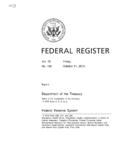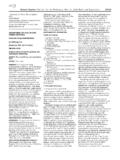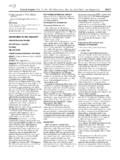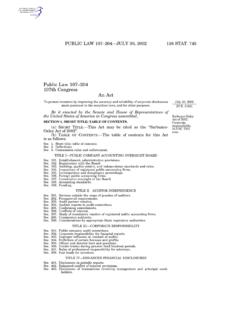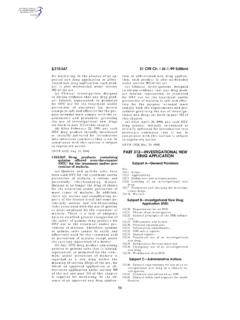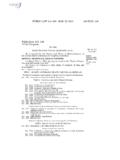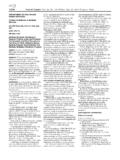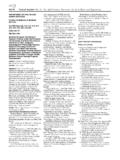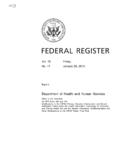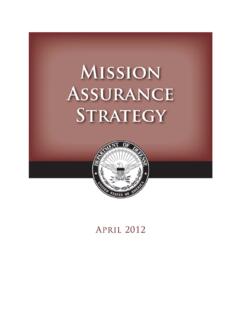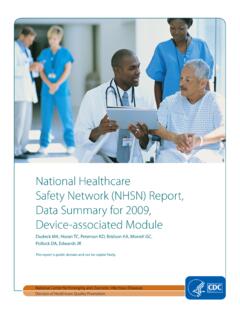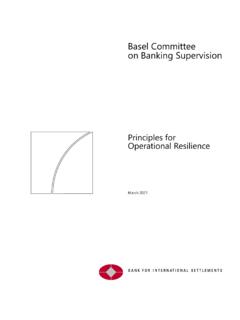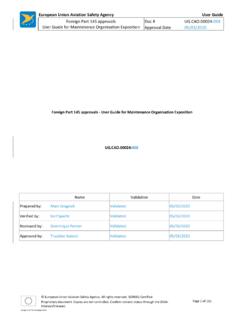Transcription of Federal Continuity Directive 1 - GPO
1 Department of Homeland Security Federal Emergency Management Agency Federal Continuity Directive 1 Issue Date: January 17, 2017 Federal Continuity Directive 1 Federal Executive Branch National Continuity Program and Requirements FCD-1 2 Table of Contents Purpose_____ 3 I. Scope_____ 3 II. Supersession_____ 3 III. Policy and Background_____ 3 IV. Roles and Responsibilities _____ 5 V. Federal Executive Level Continuity Coordination Meetings _____ 5 VI. Continuity Capability Elements _____ 6 VII. Readiness Reporting System _____ 9 VIII. Continuity Operational Phases and Implementation _____ 9 IX. Coordination with State, Local, Tribal, and Territorial Governments, Organizations, and Private Sector critical Infrastructure Owners and Operators _____ 9 Operations Security _____ 10 XI.
2 Point of Contact_____ 10 XII. Distribution _____ 11 A: PROGRAM MANAGEMENT, PLANS, AND PROCEDURES _____ A-1 ANNEX B: ESSENTIAL FUNCTIONS _____ B-1 ANNEX C: ORDERS OF SUCCESSION _____ C-1 ANNEX D: DELEGATIONS OF AUTHORITY _____ D-1 ANNEX E: COMMUNICATIONS AND INFORMATION SYSTEMS _____ E-1 ANNEX F: ESSENTIAL RECORDS MANAGEMENT _____ F-1 ANNEX G: ALTERNATE LOCATIONS _____ G-1 ANNEX H: HUMAN RESOURCES _____ H-1 ANNEX I: DEVOLUTION _____ I-1 ANNEX J: RECONSTITUTION _____ J-1 ANNEX K: TEST, TRAINING, AND EXERCISE PROGRAM _____ K-1 ANNEX L: Continuity OPERATIONAL PHASES AND IMPLEMENTATION __ L-1 ANNEX M: ACRONYMS _____ M-1 ANNEX N: DEFINITIONS _____ N-1 ANNEX O: AUTHORITIES AND RESOURCES _____ O-1 FCD-1 3 Purpose Policy Directive 40 (PPD-40), National Continuity Policy, directs the Secretary of Homeland Security through the Administrator of the Federal Emergency Management Agency (FEMA) to coordinate the implementation, execution, and assessment of Continuity activities among executive departments and agencies (D/As).
3 Specifically, the Administrator of FEMA is directed to develop and promulgate Federal Continuity Directives to establish Continuity program and planning requirements for executive departments and agencies. This Federal Continuity Directive 1 (FCD-1) implements this requirement by establishing the framework, requirements, and processes to support the development of D/As Continuity programs and by specifying and defining elements of a Continuity plan. These required elements include delineation of essential functions; succession to office and delegations of authority; safekeeping of and access to essential records; Continuity locations; Continuity communications; human resources planning; devolution of essential functions; reconstitution; and program validation through testing, training, and exercises (TT&E).
4 Scope accordance with PPD-40, the provisions of this FCD apply to the D/As enumerated in 5 United States Code ( ) 101, including the Department of Homeland Security (DHS), independent establishments as defined by 5 104(1), government corporations as defined by 5 103(1), and the United States Postal Service. The D/As, commissions, bureaus, boards, and independent organizations are hereinafter referred to as Organizations to better reflect the diverse organizational structures within the Executive Branch. The provisions of this FCD are applicable at all levels of Executive Branch organizations regardless of their location, including regional and field locations. Headquarters (HQ) elements are responsible for providing oversight and promulgating this Directive to their subcomponent and field organizations.
5 In this FCD, the term headquarters refers to the central, head offices of operations for organizations identified in PPD-40, Annex A, Categories of Departments and Agencies. The terms component or subcomponent refer to all organizational elements, whether at headquarters or a regional or field office. Supersession FCD rescinds and supersedes FCD-1, Federal Executive Branch Continuity Program and Requirements, February 2012. Policy and Background Policy: As established in PPD-40, it is the policy of the United States to maintain a comprehensive and effective Continuity capability through Continuity of Operations (COOP), Continuity of Government (COG), and Enduring Constitutional Government (ECG) programs, ensuring the resilience and preservation of government structure under the United States Constitution and the continuous performance of National Essential Functions (NEFs) under all conditions.
6 National Continuity programs are based on the continuous performance of NEFs through the sustainment of essential functions performed by D/As. NEFs are the focal point of all Continuity programs and capabilities and represent the overarching responsibilities of the Federal Government to lead and FCD-1 4 sustain the Nation before, during, and in the aftermath of a catastrophic emergency. The NEFs are: 1) Ensuring the continued functioning of our form of government under the United States Constitution, including the functioning of three separate branches of government; 2) Providing leadership visible to the Nation and the world and maintaining the trust and confidence of the American people; 3) Defending the United States against all enemies, foreign and domestic, and preventing or interdicting attacks against the United States or its people, property, or interests; 4) Maintaining and fostering effective relationships with foreign nations.
7 5) Protecting against threats to the homeland and bringing to justice perpetrators of crimes or attacks against the United States or its people, property, or interests; 6) Providing rapid and effective response to and recovery from the domestic consequences of an attack or other incident; 7) Protecting and stabilizing the Nation s economy and ensuring public confidence in its financial systems; and, 8) Providing for Federal Government services that address the national health, safety, and welfare needs of the United States. B. Background: On May 4, 2007, the President signed National Security Presidential Directive (NSPD)-51/Homeland Security Presidential Directive (HSPD)-20, National Continuity Policy, to establish a comprehensive national policy for the Continuity of Federal Government structures and operations, a single National Continuity Coordinator responsible for coordinating the development and implementation of Federal Continuity policies, and the National Essential Functions.
8 In conjunction with NSPD-51/HSPD-20, the White House published the National Continuity Policy Implementation Plan (NCPIP), which provided greater detail on how D/As were to accomplish the requirements of the policy. In 2008, as directed in the policy, DHS published FCD-1 to establish Continuity planning requirements for D/As. FCD-1 was updated in 2012. On July 15, 2016, the President signed PPD-40, National Continuity Policy, which replacedNSPD-51/HSPD-20 and the NCPIP, addressing lessons learned, best practices, and the integration of new technologies and processes since 2007. Some relevant material in the NCPIP was added to PPD-40 and certain portions were adopted in this FCD. Proper implementation of PPD-40 will ensure that essential functions are sustained in an all -hazards environment.
9 The complexity of this environment increases the need for comprehensive Continuity programs that emphasize agility and flexibility to sustain essential functions across a broad spectrum of conditions. Organizations must fully integrate Continuity planning and procedures into all aspects of daily operations to create a culture of Continuity . Only with a coordinated approach to FCD-1 5 Continuity can organizations effectively respond to and recover from catastrophic emergencies. This new FCD-1 establishes minimum Continuity standards for D/As to incorporate into their daily operations to ensure seamless and immediate continuation of essential functions. All Federal Executive Branch D/As, regardless of their size or location, shall have a viable Continuity capability, based on the requirements and principles outlined herein, to ensure resiliency and continued performance of their organizations essential functions under all conditions.
10 Roles and Responsibilities requires appointment of a Continuity Coordinator at the Assistant Secretary level or higher. As a recommended best practice, D/As should consider appointing a Continuity Manager to handle day-to-day management of the Continuity program. These roles are further explained below, but D/As should feel free to designate other positions, as desired, to assist in coordinating the implementation, execution, and evaluation of Continuity plans and programs within an organization and to ensure that programs address the entirety of essential functions rather than limit scope to only headquarters: A. Continuity Coordinator: The senior D/A official responsible for coordinating with the Organization Head and national Continuity leadership to ensure the organization maintains a viable and effective Continuity capability.

